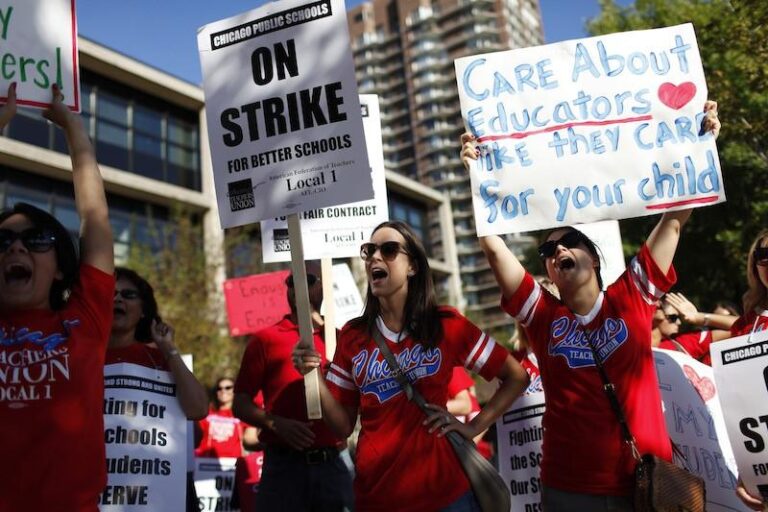As debates over the state of American education intensify, a growing chorus of critics is pointing fingers at teachers unions, arguing that their priorities may not align with the best interests of students. In this opinion piece, we examine the claim that schools across the country are facing significant challenges because teachers unions, often at the center of education policy battles, are perceived to put their own agendas ahead of children’s needs. This analysis explores how union actions and policies may be impacting school performance, classroom environments, and ultimately, student outcomes.
The Impact of Union Policies on Classroom Resources and Student Performance
Union policies have significantly influenced the allocation of classroom resources, often prioritizing teacher benefits over direct student needs. Budget negotiations and contract stipulations dictated by unions frequently limit school administrators’ ability to invest in cutting-edge learning materials, technology, and support staff. As a result, essential resources that could enhance educational experiences and outcomes remain underfunded or outdated. While teacher compensation and working conditions are critical, the rigid frameworks set by unions sometimes hinder innovations aimed at improving classroom environments for students.
The consequences of these policies manifest clearly in student performance metrics. Schools governed by stringent union contracts tend to report stagnating test scores and achievement gaps. Below is a comparison of resource allocation versus student test score changes over five years in districts with strong union influence:
| District Type | Resource Investment Change (%) | Student Test Score Growth (%) |
|---|---|---|
| High Union Influence | +2 | +1 |
| Moderate Union Influence | +5 | +4 |
| Low Union Influence | +10 | +8 |
This data suggest that union-driven resource constraints correlate with slower academic progress. To genuinely prioritize student success, policies must shift towards increased flexibility in funding distribution, including:
- Updating classroom technology regularly to keep pace with educational advancements.
- Expanding support staff such as counselors and teaching aides to address diverse student needs.
- Allocating funds directly for curriculum development tailored to student performance data.
How Collective Bargaining Priorities Can Hinder Educational Progress
At the heart of ongoing challenges in many public schools lies a complex dynamic where collective bargaining priorities often clash with the urgent needs of students. Rather than focusing primarily on enhancing classroom resources or reducing class sizes, negotiations frequently emphasize issues like job security and pension benefits. This approach can inadvertently maintain outdated structures that limit flexibility for innovation and adaptation in teaching methods.
Key concerns include:
- Rigid work rules: Restrictions on teacher assignments and school schedules impede tailored learning experiences.
- Resistance to accountability: Protective mechanisms make it difficult to address underperformance effectively.
- Budget allocation conflicts: Funds prioritized for union contracts often leave less room for technology, enrichment programs, or infrastructure improvements.
| Collective Bargaining Focus | Impact on Students |
|---|---|
| Salary and Benefits | Limits funds for updated resources |
| Senior Teacher Protection | Restricts personnel flexibility |
| Strict Work Rules | Reduces instructional innovation |
Balancing Teacher Rights with Student Needs for Better School Outcomes
Effective education demands a delicate equilibrium between protecting teacher rights and prioritizing student outcomes. While teacher unions play a vital role in advocating for fair wages, job security, and professional development, these objectives must not overshadow the core mission of education: delivering quality learning experiences to every child. Excessive rigidity in union contracts sometimes restricts the ability of schools to adapt swiftly to students’ evolving academic and emotional needs, hindering interventions that could close achievement gaps or address behavioral challenges. Empowering educators with flexibility alongside security can foster innovation and responsiveness in classrooms.
- Collaborative contract reforms: Allowing input from teachers, administrators, and parents to align priorities.
- Student-centered evaluations: Incorporating metrics that focus on growth and well-being rather than solely teacher tenure.
- Professional autonomy: Providing teachers discretion to tailor instruction without bureaucratic constraints.
- Regular impact assessments: Ensuring union policies contribute positively to student success rates.
| Aspect | Teacher Union Priority | Student Needs Focus |
|---|---|---|
| Contract Flexibility | Highly regulated | Adaptive approaches |
| Performance Assessment | Seniority-based | Growth-oriented |
| Resource Allocation | Equitable salaries | Targeted interventions |
| Professional Development | Union-guided | Student-driven skills |
Policy Recommendations to Realign Unions with the Interests of Students
To foster an educational environment truly centered on student success, unions must adopt policies that prioritize learning outcomes over rigid contractual protections. First, transparency should be mandatory in union negotiations, enabling parents, educators, and policymakers to understand how decisions impact classroom dynamics. Additionally, unions should embrace flexible staffing models that allow schools to adjust teacher roles based on student needs, rather than strictly adhering to seniority rules that can inadvertently hinder optimal placements. Encouraging collaboration between administrators and union leaders can ensure that teacher support systems align more directly with improving student achievement.
Another critical measure is the implementation of performance-based incentives that reward tangible improvements in student learning, rather than solely focusing on years of service or tenure. These incentives could include professional development opportunities geared toward innovative teaching strategies and measurable skill gains. Below is a simple illustration comparing traditional union priorities with potential student-centered reforms:
| Traditional Union Focus | Student-First Policy Alternative |
|---|---|
| Seniority-based layoffs | Retention based on student outcomes and versatility |
| Limited transparency in contract terms | Open negotiation sessions accessible to public |
| One-size-fits-all professional development | Targeted training aligned with evolving student needs |
| Salary increases tied to tenure | Bonuses for demonstrable classroom impact |
Wrapping Up
As the debate over education policy continues, the perspectives presented here underscore the urgency of reevaluating the role of teachers unions in shaping America’s schools. With student achievement and well-being at stake, stakeholders must prioritize children’s needs above all else. Finding common ground that serves both educators and students will be essential in reversing the struggles facing our education system.




